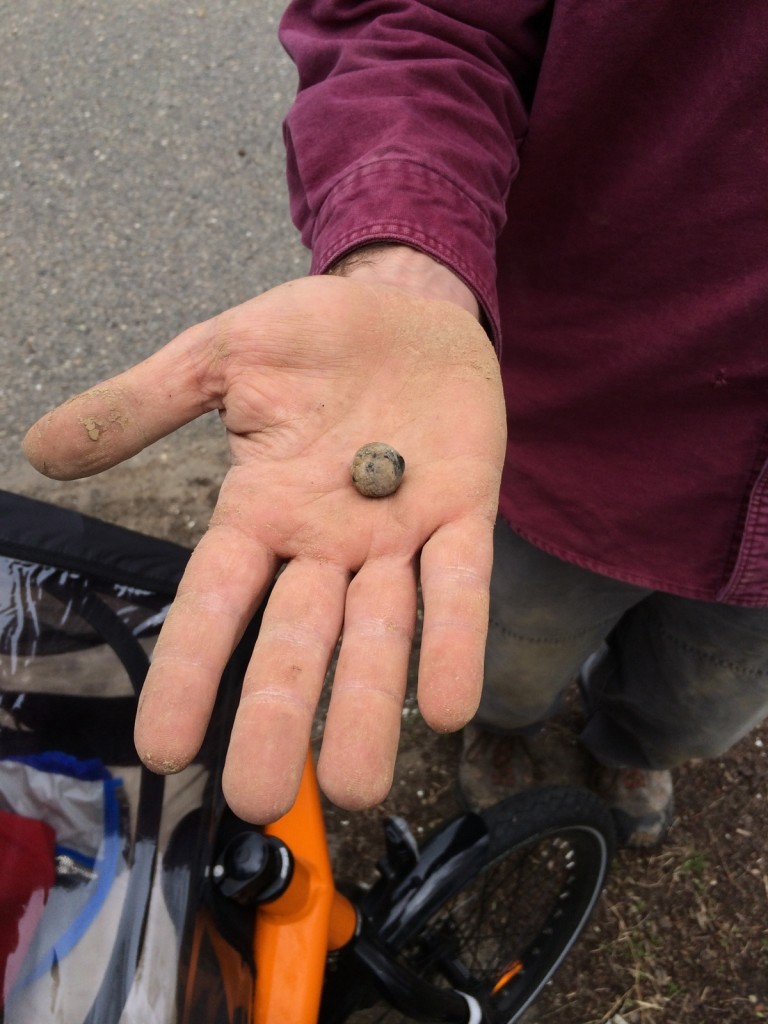Just this evening, we reached the bottom of the 1814 fortifications in our northern testing unit and recovered a musket ball from the War of 1812. Huzzah!


Just this evening, we reached the bottom of the 1814 fortifications in our northern testing unit and recovered a musket ball from the War of 1812. Huzzah!
Our project team spent their first week following up on the remote-sensing study conducted by Dr. Tim Horsley last month. Tim’s study gave us two big leads: evidence of the old fortification ditch and evidence of a building and cellar we believe may be Jacob Loudenslager’s tavern and the field headquarters during the Battle of Baltimore.
To learn more about these features, the team opened three trenches, including one at the tavern site and two to test the old fortification ditch. Fieldwork Director Greg Katz shared his reflections on the first week in the field:
The testing of the tavern area has gone very well. We found the remains of what we think is a brick foundation on the very first day of the investigation. So far, the search for the trench has been less successful. While we located signs of the original fortification in the southern trench, we also found a drain that looks like a later feature (likely installed between 1827 and the 1853 when the area was turned into a public park).
According to the remote sensing survey, the northern ditch was supposed to be buried just over 3 feet below ground but we have not yet found anything that’s clearly the fortification yet so we have to go a little bit deeper still. I’m excited that so much of the 19th century landscape seems to still be intact but we still have a lot of work to do and it’s been taking a long time to get the information that we have so far so we have to try to be very careful from here going out strategic in terms of what amount what testing were going to be able to accomplish.

Archeologists Dig Up 200-Year-Old History In Patterson Park, WJZ News Sun, April 21, 2014.
They’re searching for history on what used to be Hampstead Hill. Using high-tech radar and shovels, Baltimore Heritage has launched an archeological dig in Patterson Park.
“We started out here with our remote sensing. We have ground penetrating radar. This is a way to cover a lot of ground quickly without disturbing the soil. We try to dig as little as possible on a really historic site because we don’t want to damage the site,” said archeologist John Bedell, of Louis Berger Group. Bedell says it’s a great Baltimore story, where 15,000 proud city residents and dozens of cannons formed a line of defense against the British in 1814.

Patterson Park dig uncovering traces of War of 1812 militia camp, defenses, Scott Dance, Baltimore Sun, April 20, 2014.
When Samuel Smith, major general of the Maryland militia, needed a headquarters to plot Baltimore’s defense from British invaders in the summer of 1814, archaeologists believe he called on the owner of a shop that gives Butcher’s Hill its name. Jacob Laudenslager leased much of what is Patterson Park today from landowner William Patterson, including a butcher’s shop steps from where the park’s iconic observatory sits today.
Archaeologists have uncovered a wall of that structure as they embark on a dig for a better understanding of what happened when thousands of militiamen camped along the hills of southeast Baltimore during the War of 1812. An excavation that began Wednesday has uncovered artifacts including bricks, mortar, glass, nails, shards of pottery and a gunflint — used to ignite gunpowder inside 19th century firearms.
Thanks to everyone who came out this morning to join us at our community open house in Patterson Park. With tours of the Observatory and our Witness to the War of 1812 banner we shared the history of Hampstead Hill and the Battle of Baltimore. Our archeology team and volunteers are learning more day by day so please join us next Saturday for more updates on the project. We’re also looking forward to welcoming more visitors to the park next week when we start offering field trips to local students thanks to our partnership with Baltimore City Public Schools.